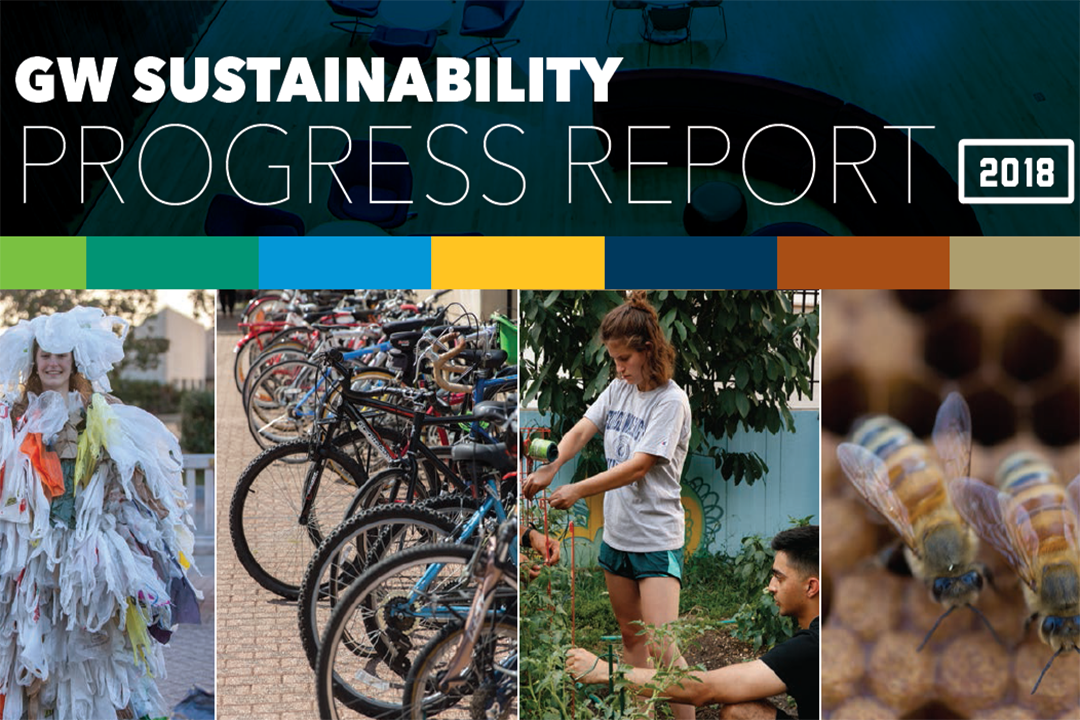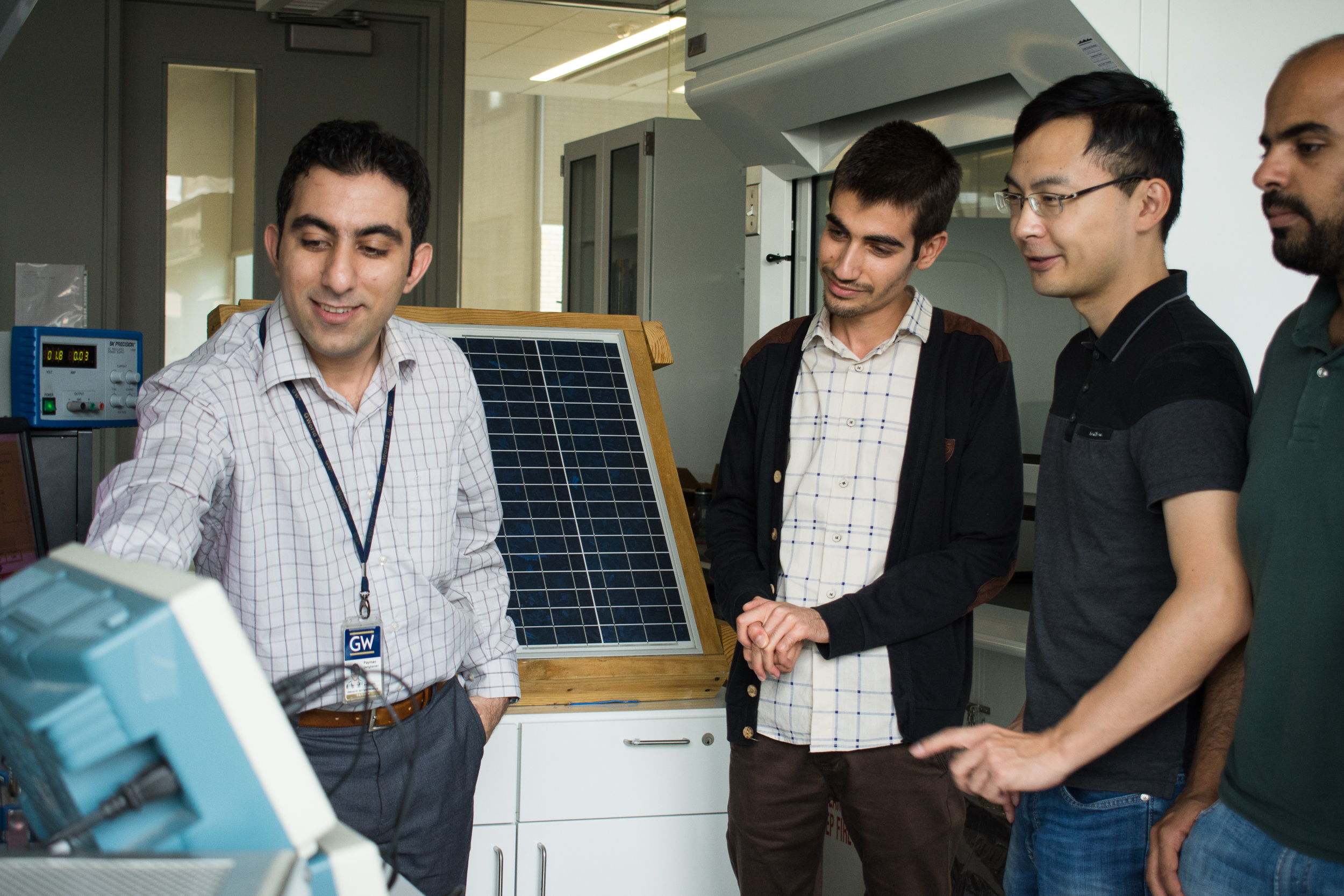George Washington University made significant progress toward its sustainability goals during fiscal year 2017, a new report from Sustainable GW states, especially in waste diversion.
The report reviews the university’s progress toward the seven goals that were set in 2012 and provides an opportunity for the university community to continue moving toward these goals with practical steps, Office of Sustainability Director Meghan Chapple explained in a letter accompanying the report.
The report shows that the university already has exceeded targets in waste diversion and low-carbon technology generation for 2020 and 2040, respectively, and continues making progress in other areas such as water consumption and sustainable investment.
"From climate change to the loss of biodiversity, living sustainably on Earth has become one of the central challenges of our time,” Ms. Chapple said. “GW's sustainability progress thus far is a result of the tireless efforts of students, faculty, staff and partners across the university and in the community.
"By bringing our strengths and challenges into sharper focus, this report will help us reach the milestones ahead."
Increasing Waste Diversion
More than 40 percent of waste was recycled, composted or reused in FY17, the report states, which is about 1,800 tons of waste diverted from a landfill. This translates to removing about 5,000 metric tons of carbon dioxide equivalent (MTCDE) greenhouse gas emissions. This is also the equivalent of about 225,000 trash bags of waste recycled rather than landfilled.
There was also an increase in reuse from 150 tons in FY16 to 530 tons in FY17. This can largely be attributed to the GW ReUSE program, which cleared out furniture from Thurston Hall in August 2016 and removed furniture from several residence halls such as Fulbright, Cole, Clark and Merriweather Halls in June 2017. All furniture collected that cannot be reused at GW is donated to local community groups as a way to avoid sending it to a landfill while helping the community.
"Our un-needed items have benefited schools, charities, nonprofit programs, homeless shelters, new start programs, churches and a center for adults with disabilities. ReUse’s donations to help others have extended beyond the D.C. metro area to groups in the Shenandoah Valley, Appalachia, Warsaw, Virginia, New York and Africa," said Bobbie Ballard, ReUSE program manager for the Division of Operations.
Composting at GW is beginning to show signs of potential and doubled from FY16 to FY17 because of the new food vendors in District House, zero waste coordinator Kris Ferguson said. Once the vendors opened in FY17, he added, his team worked with them to divert food scraps and coffee grounds. The university community can get involved with GW Compost, which holds collections on Friday mornings in Kogan Plaza along Tabling Row.
Reducing Greenhouse Gas Emissions and Water Consumption
The university continues to address its commitment to reducing its carbon footprint through energy efficiency projects on campus and clean energy purchases. This Capital Partners Solar Project (CPSP) provides solar power for GW, American University and the George Washington University Hospital.
The project, developed in 2014 with Duke Energy Renewables, provides 50 percent of the university’s electricity needs with solar power. The project helps all three institutions reduce their carbon footprint significantly. At GW, the project abates approximately 40,000 metric tons of carbon dioxide equivalent (MTCO2e) annually compared to conventional electricity— the equivalent of 9,340 passenger vehicles driven for one year. The report highlights that GW has been awarded for this innovative project by the Environmental Protection Agency Green Power Partnership and Second Nature Climate Leadership Commitment. In addition, the report says that GW received a Gold rating by the Sustainability Tracking and Reporting Initiative.
More than 40 percent of GW’s greenhouse gas emissions in FY17 come from air travel and other modes of transportation, with air travel alone accounting for roughly 30 percent. Individuals can offset the impact of their air travel with online calculators and offset programs. The Office of Sustainability plans to work with partners to identify ways to help individuals at GW address their footprints.
With low-flow water fixtures, enhancements to infrastructure, the addition of rain barrels and cisterns for reuse and programs to monitor and repair leaks, GW invested in reducing its water consumption in campus buildings in FY17. Since the Eco-Building program launched in 2012, there have been marked improvements in upgraded toilets, faucets and showerheads in 40 GW buildings.
In buildings that benefited from the Eco-Building program, water consumption reduction, compared to GW’s historic building average, grew 3 percent from FY16 to FY17 (26 percent to 29 percent), and to continue progress the university community is encouraged to report any leaky faucets by submitting a FixIt request. The community also can improve GW’s water footprint by turning off the water while washing hands and brushing teeth and by using reusable water bottles. Already, students and others have filled more than 1,380,000 reusable water bottles.
The permeable area—surfaces that allow water to get into the soil instead of running off into drains —in the Foggy Bottom campus increased from just over 13 percent in FY11 to just under 17 percent in FY17, the report states. This includes District House’s green roof, which is just over 12,500 square feet.
Sustainable Initiatives
Students are taking leadership positions on and off campus and having a positive impact. Through the Eco-Equity Challenge students are finding solutions to environmental justice problems in the District of Columbia, while students with the GroW Garden, Eco-Rep Program and Green GW are taking action to improve sustainability on campus.
The report features an update on the undergraduate minor in sustainability and sustainability related research. Students from all majors across campus can add value to their degrees by pursuing a minor in sustainability. Currently, over 200 students are enrolled.
Given the scale of GW’s commitments and the ongoing challenges presented by climate change, the university will continue to report on its performance in the coming years. The Sustainable GW team, which includes the Office of Sustainability, welcomes feedback on the report. Students can share ideas on the future of sustainability at an event on Feb. 15.



